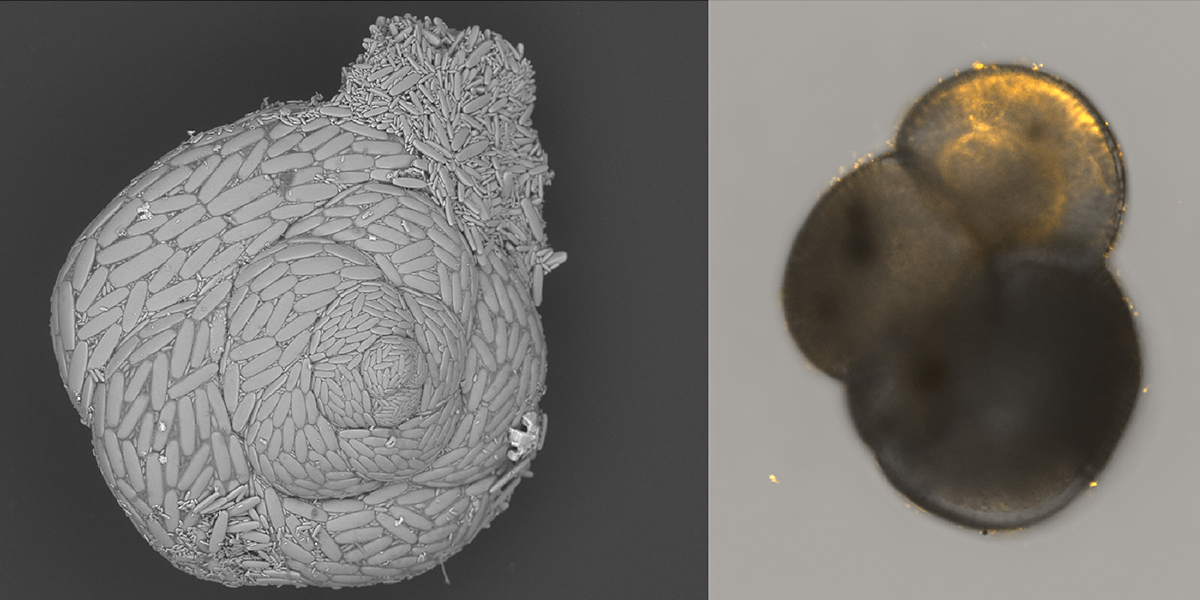Calcification
Shells made by marine organisms influence atmospheric CO2 concentrations. Increased shell formation leads to more dissolved CO2 in the ocean, thus less of it is taken up from the atmosphere. It is difficult to estimate this contribution to future atmospheric CO2 scenarios since these marine calcifying organisms are themselves affected by CO2 dissolution (i.e. ocean acidification). To understand the feedback between shell formation and CO2, we will integrate high-resolution microscopy and new spectroscopic techniques to observe calcification with unprecedented resolution. This will unlock one of the key unknowns in the global marine carbonate-CO2 feedback loop.
|
|
|
Only by combining our expertise in global ocean changes and biomineralization can we probe the implications of ocean acidification for climate change. |
| Lennart de Nooijer, Helen King |

Project Team

Project description
Ocean acidification is the second most important effect of burning fossil fuels. Ongoing dissolution of CO2 lowers the saturation state of seawater to Ca-carbonate precipitation and hence, makes it more difficult for corals, bivalves, etc. to make their shells and skeletons. At least, that is the common assumption. Contradictory to this assumption there are indications that marine calcifiers can also benefit from added carbon dioxide, which makes it currently impossible to predict which way this feedback loop will affect ongoing climate change. We propose to study the relation between marine carbon and calcification in foraminifera, one of the major marine shell producers, who precipitate their shells in a confined space, where the conditions are different than those in the surrounding seawater. The biological mechanisms responsible for this is a key fundamental unknown and consists of 1) the transport of ions over cell membranes and 2) the crystallization pathway taken once these ions are transported.
Calcification by foraminifera can be observed in the laboratory and with NIOZ’s recently installed confocal laser scanning microscope can now be viewed with previously unprecedented resolution. Moreover, the system is equipped with a temperature and CO2-regulation mechanism so that calcification can be observed in situ at a range of CO2 scenarios. Investigating Ca2+ and carbon uptake combined with pH imaging techniques will show changes in chemistry inside and outside the foraminifer during calcification. To observe calcification at a nm-scale resolution, we will microtome the same foraminifera for quantitative analysis of the vitrified calcifying solution chemistry using energy dispersive X-ray spectroscopy (EDX) within a transmission electron microscope (TEM).

Calcification in a foraminifer and its feedback to the marine inorganic carbon system. More CO2 may result in less calcification (left side) or more calcification (right side). Although unknown, these options will have opposite effects on surface seawater CO2 and thus, dissolution of atmospheric CO2.
Foraminifera show changes in their CaCO3 phase trace chemistry during different stages of calcification, which is either a cause or consequence of the crystallization pathway. At the NIOZ, extracellular pH micro-electrode measurements will connect CaCO3 phase formation with transmembrane ion transport (e.g. Ca2+/H+ exchange). Subsequently, calcifying foraminifera will be fixed at various stages during calcification and analyzed with photo-induced force microscopy (PiFM) to identify the Ca-carbonate phases present, as well as the chemistry of the calcite using nanoscale secondary ion mass spectrometry (NanoSIMS). PiFM is a state-of-the-art technique that can characterize both organic molecules and mineral phases at nanometer spatial resolution by combining atomic force microscopy with infrared spectroscopy.
The fluid chemistry and its development over time will be combined with CaCO3 precipitation and phase transitions into a conceptual framework to understand the two-way interaction between ion transport and mineralization. This model will integrate both UU- and NIOZ-derived results and aims to understand precipitation dynamics via thermodynamic solution speciation calculations and also how ions other than Ca2+ and CO32- are incorporated/isotopes are fractionated. This framework will be tested using newly developed ‘Crystal Hotel’ microfluidic chips. Current chip materials will be modified to better replicate the hydrophilic nature of organic membranes. Preprogrammed spatial mapping using Raman spectroscopy will monitor phase transformation in individual rooms. Results from the high-resolution confocal microscopy will show what solution chemistries to apply.
Read more +
Connected themes
- Our Future Ocean
